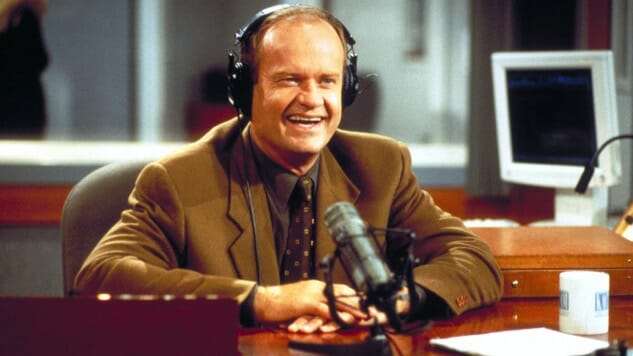The Legacy of Dr. Frasier Crane

There is a line in “Caught in the Act,” one of the final episodes of Frasier, that gets a huge laugh from the audience. It is, perhaps, the biggest studio laugh in the history of the show, and that’s accounting for over 200 episodes of television. Frasier Crane has run into his first ex-wife, Nanette, who makes her living as a children’s singer and performer called “Nanny G.” At one point, in a fit of frustration, she exclaims, “Do you know what it is like to play the same character for 20 years?!” On its surface, and devoid of context, this is not a terribly funny line. But the hilarity stems from the fact that for 20 years, everybody in that audience had been watching Kelsey Grammer play Frasier Crane. It was a metatextual shout-out to the man who was, soon, going to be leaving behind the character that defined him (sorry, Sideshow Bob fans). Kesley Grammer is Frasier Crane. He made him into one of the most indelible sitcom characters of all time, thanks not only to his longevity, but also to the gusto with which Grammer managed to play him, even when he was well over a decade into the role.
Grammer’s twenty year-long performance set a record for one actor playing a single character on television until Richard “The Belz” Belzer bested him (and James Arness, who was tied with Grammer) with his seemingly neverending portrayal of Dr. Munch on a variety of shows. Frasier made his first appearance in the first part of the two-parter “Rebound,” the third season premiere of Cheers. The episode aired September 27, 1984. While Cheers is considered a juggernaut now, one of the most popular, beloved sitcoms of all-time, it actually took a little while for the show to find its legs, in terms of an audience. By the third season, though, Cheers began to take off, with Grammer now along for the ride as the show’s regular cast began to expand.
For the first couple of seasons, Frasier was only a recurring character. He appeared in the role of a psychiatrist to help Sam Malone, the show’s ostensible lead, or at least the first amongst equals, and also as a love interest for Diane Chambers. He ended up, naturally, jilted by Diane, but by then he was established in the world of that bar. Frasier, and Grammer, brought a new energy to the ensemble. Most of the patrons at the bar were not especially bright. Diane was fairly smart, but her role in the show was very different, and Shelley Long left the series after five seasons. Without Frasier, the bar would have consisted of nothing but lunkheads and the faux intellectual Cliff Clavin. Frasier, in his role as a psychiatrist, was there to provide insight, which included pointing out the faults of others. And of course, Frasier had a pompous air about himself that resulted in his own amusing flaws.
Grammer has made a living out of being haughty in his performance. He’s a ham, but a wonderful ham. His scenery chewing has always fit into the world of the multi-cam sitcom, or voice acting and his energy was vital to Cheers. It’s also important to consider whether or note, without Frasier, we would have Lilith. Presumably not, and a world without Lilith in it is not one worth contemplating. Bebe Neuwirth emerged as a perfect foil to Frasier, and watching the two characters snipe at each other, whilst in love or otherwise, was always a delight. Though Grammer didn’t show up on Cheers until its third season, and wasn’t a main cast member until Season Five, he still appeared in 204 episodes—as in, more episodes than anybody else, other than Sam, Carla, Norm and Cliff. Throughout his time, Grammer was nominated for two Emmys. It was a fine run that could have ended there, and Frasier Crane would have been an indelible characters, just like Norm and Cliff. His name would have always come up, during those arguments about who your favorite Cheers barfly was. The series ended in May of 1993, but the legacy of Dr. Frasier Crane was just beginning to unfold. September of that very same year, Frasier began its run.
-

-

-

-

-

-

-

-

-

-

-

-

-

-

-

-

-

-

-

-

-

-

-

-

-

-

-

-

-

-

-

-

-

-

-

-

-

-

-

-








































